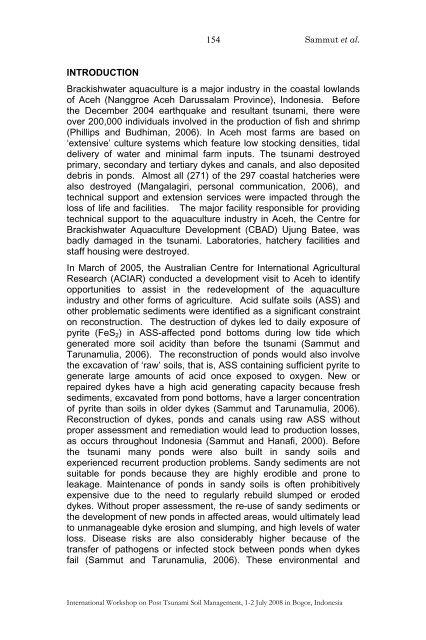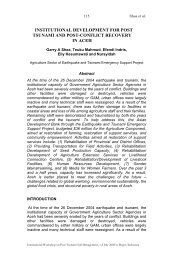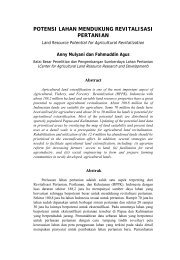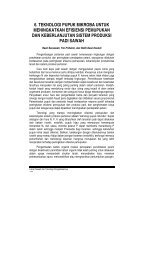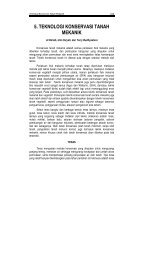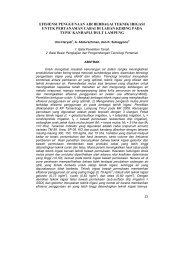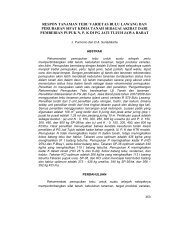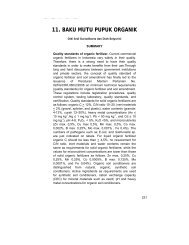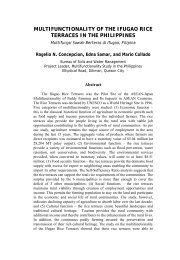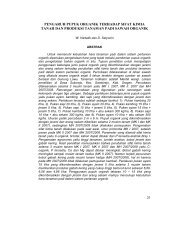Proceedings - Balai Penelitian Tanah
Proceedings - Balai Penelitian Tanah
Proceedings - Balai Penelitian Tanah
You also want an ePaper? Increase the reach of your titles
YUMPU automatically turns print PDFs into web optimized ePapers that Google loves.
INTRODUCTION<br />
154<br />
Sammut et al.<br />
Brackishwater aquaculture is a major industry in the coastal lowlands<br />
of Aceh (Nanggroe Aceh Darussalam Province), Indonesia. Before<br />
the December 2004 earthquake and resultant tsunami, there were<br />
over 200,000 individuals involved in the production of fish and shrimp<br />
(Phillips and Budhiman, 2006). In Aceh most farms are based on<br />
‘extensive’ culture systems which feature low stocking densities, tidal<br />
delivery of water and minimal farm inputs. The tsunami destroyed<br />
primary, secondary and tertiary dykes and canals, and also deposited<br />
debris in ponds. Almost all (271) of the 297 coastal hatcheries were<br />
also destroyed (Mangalagiri, personal communication, 2006), and<br />
technical support and extension services were impacted through the<br />
loss of life and facilities. The major facility responsible for providing<br />
technical support to the aquaculture industry in Aceh, the Centre for<br />
Brackishwater Aquaculture Development (CBAD) Ujung Batee, was<br />
badly damaged in the tsunami. Laboratories, hatchery facilities and<br />
staff housing were destroyed.<br />
In March of 2005, the Australian Centre for International Agricultural<br />
Research (ACIAR) conducted a development visit to Aceh to identify<br />
opportunities to assist in the redevelopment of the aquaculture<br />
industry and other forms of agriculture. Acid sulfate soils (ASS) and<br />
other problematic sediments were identified as a significant constraint<br />
on reconstruction. The destruction of dykes led to daily exposure of<br />
pyrite (FeS2) in ASS-affected pond bottoms during low tide which<br />
generated more soil acidity than before the tsunami (Sammut and<br />
Tarunamulia, 2006). The reconstruction of ponds would also involve<br />
the excavation of ‘raw’ soils, that is, ASS containing sufficient pyrite to<br />
generate large amounts of acid once exposed to oxygen. New or<br />
repaired dykes have a high acid generating capacity because fresh<br />
sediments, excavated from pond bottoms, have a larger concentration<br />
of pyrite than soils in older dykes (Sammut and Tarunamulia, 2006).<br />
Reconstruction of dykes, ponds and canals using raw ASS without<br />
proper assessment and remediation would lead to production losses,<br />
as occurs throughout Indonesia (Sammut and Hanafi, 2000). Before<br />
the tsunami many ponds were also built in sandy soils and<br />
experienced recurrent production problems. Sandy sediments are not<br />
suitable for ponds because they are highly erodible and prone to<br />
leakage. Maintenance of ponds in sandy soils is often prohibitively<br />
expensive due to the need to regularly rebuild slumped or eroded<br />
dykes. Without proper assessment, the re-use of sandy sediments or<br />
the development of new ponds in affected areas, would ultimately lead<br />
to unmanageable dyke erosion and slumping, and high levels of water<br />
loss. Disease risks are also considerably higher because of the<br />
transfer of pathogens or infected stock between ponds when dykes<br />
fail (Sammut and Tarunamulia, 2006). These environmental and<br />
International Workshop on Post Tsunami Soil Management, 1-2 July 2008 in Bogor, Indonesia


